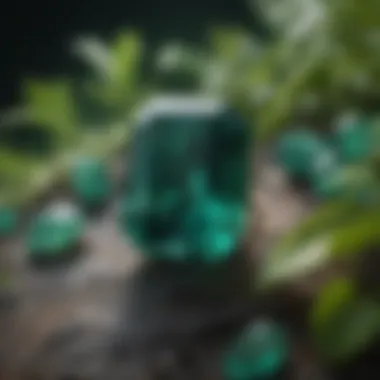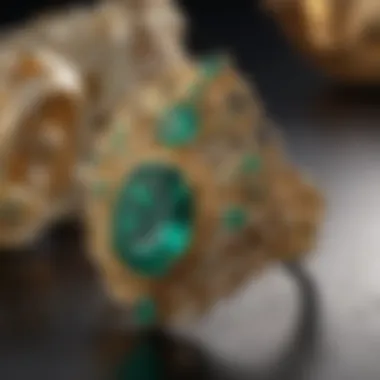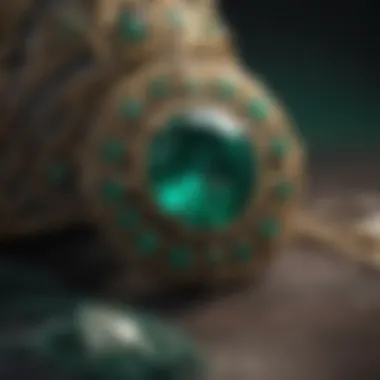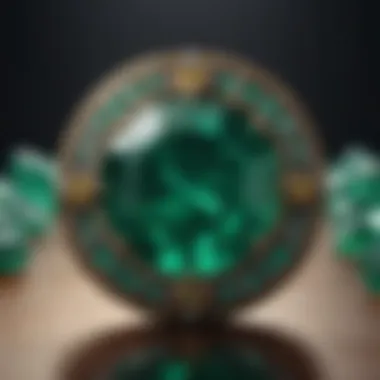The Birthstone of May: Emerald and Its Significance


Intro
The allure of emeralds is timeless, capturing the interest of geologists, jewelers, and enthusiasts alike. As the birthstone for May, emeralds hold both beauty and depth. The exploration of this gemstone reveals not only its stunning appearance but also its rich historical and cultural significance. In this journey, we will investigate the captivating properties of emeralds, their therapeutic uses, and their status in the jewelry market.
Gemstone Overview
Emerald is a variety of beryl, a mineral composed primarily of beryllium, aluminum, and silica. Its deep green color stems from the presence of chromium and sometimes vanadium. The most sought-after emeralds exhibit a vivid green hue, often described as "grass green" or "vivid green". The allure of emeralds lies not only in their color, but also in their transparency and brilliance.
Physical Properties
Emeralds have unique physical qualities:
- Color: Varies from yellowish-green to bluish-green, with deep green being most desirable.
- Hardness: Rated 7.5 to 8 on the Mohs scale, making them relatively durable but not invincible.
- Luster: Exhibits a vitreous to oily luster, enhancing visual appeal.
Commonly found in regions such as Colombia, Zambia, and Brazil, each source adds subtle differences in hue and clarity. Colombian emeralds are considered the most valuable, often displaying a rich green color with fewer inclusions compared to Zambian stones.
"Emeralds are one of the most valuable gemstones in the world, cherished for their lush green color and historical significance."
Healing Properties
Emeralds are not only appreciated for their physical beauty but also for their metaphysical properties. They are believed to promote healing, harmony, and growth. Many holistic practitioners consider emeralds beneficial for emotional and spiritual healing.
Metaphysical Attributes
Emeralds are often associated with the heart chakra. This connection is thought to encourage love, compassion, and unity.
- Healing Energy: Many believe emeralds can alleviate stress, enhance mental acuity, and help in emotional recovery.
- Symbol of Hope: Cultures across history have regarded emeralds as symbols of hope and rebirth.
Common Uses in Holistic Practices
In holistic practices, emeralds are used in various ways:
- Meditation: Holding an emerald while meditating is believed to promote clarity and peace.
- Healing Crystals: Used in crystal healing to align energies and improve emotional health.
Emeralds continue to play a role in not just decorative art, but also as tools for wellbeing, bridging the gap between aesthetic beauty and inner peace. This duality enhances their significance as the birthstone of May, deepening their connection with those born in this month.
Prelims to May Birthstones
May presents the opportunity to explore the unique significance of its birthstone, emerald. The emerald is not just a beautiful gemstone; it carries substantial historical, cultural, and metaphysical meaning that connects deeply with its admirers. Understanding this birthstone can enhance one’s appreciation, whether for personal, cultural, or investment reasons.
Emeralds have captivated humans for centuries, symbolizing growth, rebirth, and love in various contexts. The rich green color of emeralds has long been associated with spring, not just marking May's temporal arrival but embodying the spirit of renewal that comes with the season. In this article, we aim to illuminate both the sparkling allure and profound meanings of the emerald.
Overview of Birthstones
Birthstones hold significant meaning in many cultures across the globe. Traditionally linked with zodiac signs or months of the year, they are thought to enhance certain traits or foster connections for those born in that period. The practice of wearing birthstones for protective or beneficial qualities dates back centuries and spans various civilizations.
Each month is assigned a specific stone, and for May, that stone is the emerald. This unique connection offers individuals a sense of identity and belonging. Additionally, birthstones often represent personal milestones such as anniversaries, making them even more cherished.
Cultural Importance of May Birthstones
Emeralds possess a rich cultural legacy that stretches beyond mere aesthetic appeal. Many cultures have linked emeralds to prosperity and harmony. In ancient Egypt, they were believed to be a symbol of fertility and rebirth. Similarly, throughout history, royalty has favored emeralds, believing they carry luck and protection.
Different cultures have varying beliefs about the meaning of the emerald. For instance:
- In Hindu traditions, they are considered to bring wisdom and promote mental clarity.
- In ancient Persian culture, emeralds symbolized eternal life.
The significance of emeralds in May extends beyond individual interpretation; it is a collective celebration of shared history and cultural narratives. Wearing an emerald, particularly those born in May, connects them to this grand tapestry, enriching their personal and communal identity.


Geological Formation of Emerald
The geological formation of emerald is crucial in understanding its unique properties and significance. This knowledge unveils the intricate processes that contribute to the creation of this precious gemstone. By exploring the mineral composition and classification of emeralds, as well as the methodologies behind their formation and mining, one gains insight into both the physical characteristics and the broader implications of this alluring stone.
Mineral Composition and Classification
Emeralds are a variety of the mineral beryl, which is primarily composed of beryllium aluminum silicate. The chemical formula for beryl is Be3Al2(SiO3)6. What distinguishes emeralds from other beryl varieties is the presence of chromium and sometimes vanadium, which impart their rich green hues. This specific coloration ranges from light green to a deep, intense green, making them highly sought after.
typical classification scheme can be used to differentiate emeralds from their counterparts, such as:
- Type A: Natural emeralds without treatments.
- Type B: Emeralds that undergo a treatment process to enhance clarity and color.
- Type C: Emeralds that are both treated and synthetic in origin.
These classifications help consumers and collectors understand the value and quality of emeralds they choose to acquire.
Formation and Mining Processes
The formation of emeralds occurs in metamorphic and igneous environments. This process demands specific geological conditions, typically involving high-pressure and high-temperature environments. As beryl crystals form over millions of years, the presence of trace elements like chromium is vital.
Emerald mining involves several methods, which can be categorized as:
- Artisanal Mining: Often conducted manually, this method is common in places like Colombia. Miners dig into the earth to uncover emerald deposits. While it supports local economies, it can be hazardous and has minimal regulation.
- Large-Scale Mining: Industrial operations in regions like Zambia employ advanced technology to harvest emeralds. These practices yield larger quantities of gemstones but often raise environmental concerns due to their impact on ecosystems.
The extraction process itself is labor intensive. Once mined, emeralds are subjected to sorting and processing to enhance their appearance, making the final product more appealing to consumers.
Emeralds not only captivates with their beauty but also embodies the complex geological tales that precede their existence. Understanding these aspects enriches the appreciation of emeralds, making them more than just a precious stone, but a testament to nature's artistry.
Emerald's Historical Context
Emeralds have captivated human civilization for centuries, offering not only aesthetic pleasure but also a rich tapestry of historical significance. This section explores the fascinating historical context of emeralds, focusing on their role in ancient societies and the connections prominent figures established with this precious stone. Understanding this context illuminates how emeralds contributed to cultural expressions and personal identities across different epochs.
Emerald in Ancient Civilizations
Emeralds were highly valued by ancient cultures, thought to embody life and fertility. The Egyptians, known for their pioneering use of gemstones, esteemed emeralds as symbols of rebirth and immortality. They associated the stone with the goddess Isis, who represented nature and magic. Ancient Egyptians would adorn their tombs with emeralds, believing the gems could provide protection in the afterlife. Numerous relics have been unearthed, revealing emeralds that were carefully embedded in burial sites.
The Incas of South America similarly revered emeralds. They mined these gems in what is now modern-day Colombia, creating an extensive trade network surrounding their extraction. The stones were considered the "gems of the mother earth" and were often used in ceremonial garments for rituals and offerings.
Additionally, the emerald's significance stretched to the myths of ancient Rome. The Romans believed that wearing emeralds could bestow heightened intellect and eloquence. They also viewed the stone as a cure for various ailments, including eye-related disorders. Throughout history, emeralds have signified wealth and power, linking the elite to this vibrant stone, further amplifying its allure.
Significant Historical Figures and Their Affinities
Throughout different eras, many high-profile individuals cultivated an affinity for emeralds, adding layers of meaning to this gem's historical narrative. For instance, Queen Cleopatra of Egypt was renowned for her love of emeralds. She believed in their mystical properties and adorned herself with emeralds, which became symbols of her reign. Her passion for these stones created a lasting association between emeralds and regal grandeur.
Similarly, the emerald held significant meaning for international figures such as Emperor Shah Jahan, known for constructing the Taj Mahal. The emperor celebrated the brilliance of emeralds in his jewelry pieces. This connection between power and emeralds illustrates the stone's role in expressing authority and status across various cultures.
Moreover, many European monarchs from the Middle Ages onward have graced themselves with emerald jewelry. These gems became emblematic of wealth and were often featured in royal crowns and scepters.
Metaphysical Properties of Emerald
The metaphysical properties of emerald are vital in understanding its role beyond mere aesthetics. This green gemstone has long been associated with various spiritual and healing practices. The emerald’s significance in metaphysical realms derives from its energetic qualities and historical perceptions. As a stone of balance and harmony, it is believed to promote growth, renewal, and peace.
Healing Benefits and Energizing Qualities
Emeralds are often viewed as powerful healing stones. The vibrant green color is thought to resonate with the heart chakra. This connection is believed to foster emotional healing and enhance feelings of love and compassion. Some practitioners assert that wearing emeralds can help alleviate stress, promoting a sense of calm and relaxation.
Among its claimed healing benefits, emerald is thought to:
- Improve emotional well-being: This stone can support clarity in emotional matters.
- Aid in physical healing: Its energy is sometimes linked to alleviating ailments related to the heart, lungs, and even the immune system.
- Boost mental acuity: The emerald is associated with enhancing intelligence.
People interested in holistic practices may utilize the emerald in various ways. Some hold the stone during meditation, while others place it in their living spaces to attract positive energies. Many enthusiasts believe that this stone not only amplifies one’s intentions but also nurtures their spirit.


Role in Spiritual Practices
Emeralds are deeply ingrained in various spiritual practices. They are often regarded as symbols of wisdom and foresight. In many cultures, emeralds are used in rituals aimed at enhancing one's psychic abilities. They are also believed to help align the mind and the heart, making them valuable tools for those pursuing spiritual growth.
In terms of practical applications, emeralds feature in:
- Meditative practices: Individuals may hold an emerald while focusing to deepen their meditative state.
- Rituals for prosperity and abundance: The stone is often incorporated in ceremonies aimed at attracting wealth and success.
- Protection: Some believe emeralds can guard against negative energies and offer a shield during spiritual practices.
Emerald’s role in spiritual practices encourages individuals to connect with their inner selves. By fostering a sense of peace and empowerment, the emerald can become a bridge to one’s higher consciousness, allowing for a richer spiritual experience.
"Emeralds are more than beautiful stones; they represent a gateway to emotional and spiritual well-being."
In summary, the metaphysical properties of emerald artfully intertwine healing, spirituality, and personal growth. This gemstone holds a special place in various practices, serving as a reminder of the beauty that exists within us and the world around us.
Emerald in Jewelry Design
Emeralds hold a significant place in the world of jewelry design. Their stunning green hue and unique characteristics make them a desirable choice for many pieces. The use of emeralds can add a touch of elegance and sophistication to various types of jewelry. Not only do they serve aesthetic purposes, but they also can hold value as investments. When incorporating emeralds into jewelry, designers must consider factors such as color saturation, clarity, and the settings in which they are placed.
Classic Designs Featuring Emerald
Classic jewelry designs that include emeralds are timeless. These designs often feature intricate settings that enhance the stone's grand appearance. Common classic styles include:
- Solitaire Rings: A single emerald set in a simple band highlights the stone's beauty without too much distraction.
- Emerald-Cut Gemstones: This cut emphasizes the striking color and clarity of emeralds, making it a favored choice for earrings and pendants.
- Vintage Settings: These often use filigree or intricate metalwork that complements the deep green of emeralds, providing an old-world charm.
Emeralds were frequently used by royalty, seen in pieces owned by figures such as Cleopatra and Queen Elizabeth II. Such history adds prestige to the gems, making them perfect for special occasions like weddings and anniversaries.
Modern Trends in Emerald Jewelry
The modern approach to emerald jewelry includes fresh perspectives and innovative designs. Designers are experimenting with:
- Mixed Materials: Combining emeralds with other gemstones or metals offers a unique contrast that is visually appealing.
- Minimalist Designs: Clean lines and simple settings are on the rise, highlighting the vibrant green of emeralds without overwhelming distractions.
- Sustainable Practices: Many consumers today seek ethically sourced emeralds, prompting designers to focus on sustainability within their collections.
Emerald jewelry, whether worn daily or on special occasions, is making a significant comeback. Its ability to blend tradition with contemporary styles speaks volumes about its enduring appeal.
Care and Maintenance of Emeralds
Caring for emeralds is essential not only to maintain their beauty, but also to preserve their value over time. Emeralds, being one of the most prized gemstones, require special attention due to their unique properties and vulnerabilities. Unlike diamonds, which score a high level on the Mohs hardness scale, emeralds are softer and more brittle. Consequently, their care and maintenance involve particular considerations to avoid damage.
Understanding how to clean and store emerald jewelry properly can have long-term benefits. Regularly maintaining emeralds can enhance their brilliance, prolong their lifespan, and ultimately keep their monetary worth intact. Without proper care, emeralds can become dull, lose their vibrant hue, or potentially become cracked or chipped.
Cleaning and Storing Emerald Jewelry
Cleaning emerald jewelry is a delicate process. Because emeralds can be treated with oils to enhance their appearance, the type of cleaning method employed is crucial.
- Use Mild Soaps: A gentle soap mixed with warm water is ideal. Avoid harsh chemicals or heated solutions that can cause damage to the stone or its setting.
- Soft Cloths: When cleaning, use a soft, lint-free cloth to gently wipe away dirt and oil. Abrasive materials can scratch the surface of the emerald or its mounting.
- Avoid Ultrasonic Cleaners: These devices can cause fractures within the stone because emeralds often contain internal inclusions.
- Rinse Thoroughly: Ensure all soap residue is removed by rinsing with clean water.
Regarding storage, proper handling can prevent scratches and minimize the risk of damage.
- Separate Storage: Store emerald jewelry separately from other gemstones to avoid contact that might cause scratches.
- Use Pouches or Soft Bags: This will cushion the stones and prevent friction with harder substances.
- Avoid Humidity: Extreme conditions can affect the stone's integrity, so a stable environment is recommended.
Common Treatments and Enhancements
Emeralds are often treated to improve their physical appearance. Understanding these treatments is vital for both collectors and consumers.
- Oiling: The most common treatment involves the application of oils to enhance clarity. This treatment can improve the visual quality, but it is essential to note that it requires special care.
- Resin Treatments: Some emeralds are treated with synthetic resin to fill fractures, making the stone appear more flawless. Knowing this can guide how much care a specific piece requires.
- Heat Treatment: Although less common than in other gemstones, heat treatment can sometimes be applied to emeralds for color enhancement.
Proper understanding and vigilance regarding these treatments ensure that the integrity of emeralds remains intact. Well-maintained emeralds can tell a story and carry historical significance, making them not only beautiful adornments but also remarkable heirlooms.


In the world of gemstones, emeralds stand out not just for their striking color, but for the care they demand.
Emerald Market and Valuation
The emerald market holds significant importance in understanding the complexities of gemstone valuation. This section aims to dissect the elements that influence the pricing of emeralds and ways to discern their quality. For collectors and jewelry designers, an understanding of these factors is essential for making informed purchases and investments.
Factors Influencing Emerald Prices
Emerald prices are influenced by several core factors that potential buyers should consider carefully:
- Color Quality: The most critical aspect of emerald valuation is its color. A vivid, deep green hue often commands higher prices. Lighter shades may not hold the same value.
- Clarity: Unlike diamonds, some inclusions are acceptable in emeralds, resulting in a unique character. However, excessive inclusions can detract from the stone’s value. Buyers should look for stones with minimal flaws visible to the naked eye.
- Cut: The craftsmanship of the cut also affects price. Well-proportioned cuts enhance brilliance and overall appearance, while poorly cut stones may appear dull, reducing their market value.
- Carat Weight: Larger emeralds are less common, which increases their value per carat. However, beyond a certain size, the relationship may not remain linear due to the rarity of high-quality larger stones.
- Origin: The geographic origin can drastically influence price. Colombian emeralds are often considered the finest due to their superb color and clarity, which may lead to higher demand.
Identifying Quality Emeralds
Understanding how to identify quality emeralds is crucial for both collectors and designers. Here are some guidelines:
- Examine Color: Look for a rich, saturated green. Avoid stones that appear too yellowish or blueish in tone.
- Check Clarity: Try to find stones that appear clear without heavy inclusions. A loupe is a useful tool for detailed examination.
- Evaluate Cut: Inspect the cut both under natural and artificial light. Well-cut stones will reflect light evenly and reveal their brilliance.
- Verify Certification: Always seek stones that come with a gemological certificate from reputable laboratories, such as the Gemological Institute of America (GIA). This ensures authenticity and provides a detailed analysis of the stone’s attributes.
When investing in emeralds, a comprehensive understanding of market forces and quality assessment can help buyers make sound decisions.
- Focus on Transparency: Higher-quality emeralds should allow light to penetrate without excessive obstruction by inclusions.
Emerald's Cultural Symbolism
Emeralds hold a unique place in various cultures throughout history, encapsulating profound meanings and values that resonate to this day. Their rich green color is often associated with nature, vitality, and life itself. This connection allows emeralds to symbolize growth, renewal, and harmony, making them deeply significant in various cultural contexts.
Emerald in Literature and Arts
Emeralds have captured the imagination of writers and artists alike. In literature, these gemstones often appear as tokens of power and wealth. For instance, they are featured in the works of authors such as Shakespeare, where they symbolize fidelity and rebirth. Various poems and stories depict emeralds as treasure, representing not just material wealth but also spiritual clarity and wisdom.
In the realm of visual arts, emeralds are frequently depicted in paintings, sculptures, and jewelry, bringing to life the elegance of their hue. Artists throughout the ages have appreciated the unique light qualities of emeralds. The gemstones often symbolize beauty and purity in art, reinforcing their appeal as a subject worth exploring.
Emeralds have also made their way into popular media, appearing in countless films, songs, and performances. Their allure in storytelling engages audiences and cultivates a collective appreciation for their symbolism.
Emerald's Connection to Birth and Rebirth
Emeralds symbolize not only birth but also the idea of rebirth. This association can be traced to various mythologies, where emeralds are seen as symbols of fertility and new beginnings. In many ancient cultures, these gemstones were used in rituals aimed at promoting growth and renewal.
For the people of ancient Egypt, the emerald represented fertility and rebirth, often placed in tombs to ensure prosperity in the afterlife. It was said to have connections to the goddess Isis, who symbolized motherhood and fertility. This creates a cultural linkage between the emerald and the cycles of life.
In the context of modern symbolism, emeralds are celebrated as the birthstone for May, making them representative of those born in this month. They are thought to bring good fortune and vitality, allowing the wearer to harness their potential for a fresh start.
The spiritual significance of emeralds extends into meditation practices as well. People often use emeralds during these sessions to manifest growth and transformation, further solidifying their role in nurturing change and renewal in life.
Emeralds are not just gemstones; they are storytellers woven into the fabric of culture, symbolizing hope, renewal, and the cycle of life.
Finale: The Importance of Emerald
Emerald holds a unique status not only as a gemstone but also as a cultural artifact. Its significance transcends the realm of mere aesthetics, embedding itself deeply in various historical contexts and metaphysical traditions. This article has carefully explored various dimensions of emerald, including its geological formation, rich history, and multifaceted symbolism. By delving into these elements, we understand that emerald is much more than a birthstone for May; it is a reflection of human culture and belief systems.
Emerald's Enduring Legacy
Emeralds have been cherished for thousands of years. Ancient civilizations, such as the Egyptians, believed emeralds symbolized fertility and rebirth. The powerful allure of emerald has not waned over the years. Collectors and enthusiasts increasingly appreciate quality stones, while the market for emerald jewelry continues to flourish. Its rich green color and fascinating optical properties make it a timeless choice.
In modern times, the legacy of emerald is maintained through significant endorsements from iconic personalities and its frequent appearances in renowned jewelry collections. For example, personalities like Queen Cleopatra and even contemporary collectors have believed that emeralds carry protective and healing properties. This association with healing continues to attract those interested in holistic practices.
"Emeralds have a history steeped in beauty and purpose, enriching lives throughout the ages."
Future Trends in Emerald Appreciation
Emerald appreciation is likely to evolve further as collectors seek more authenticated and unique pieces. The rise of technology in gemstone evaluation has made it easier to discern quality and authenticity, thus allowing for more informed purchases.
Additionally, awareness around sustainable sourcing will shape future emerald mining practices. More consumers now prefer ethically mined stones, which could lead to a shift in how emeralds are sourced.
Lastly, as modern jewelry trends embrace vintage and bespoke designs, emeralds may become increasingly popular in one-of-a-kind pieces tailored to personal stories and experiences.







